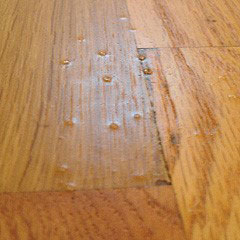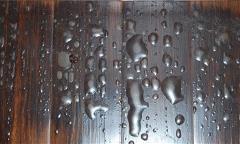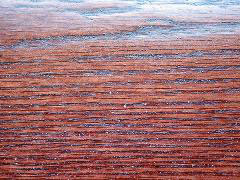
As summer heats up, rising temperatures can give rise to a host of finishing problems. Here are some common problems and their solutions.
ISSUE: Whenever finish is applied with an applicator, the churning action of  spreading works small bubbles into the floor surface. Normally the bubbles will break out in a few seconds, resulting in a smooth and even finish. However, when airflow is warm, the warm air blowing across the freshly applied finish can cause the bubbles not to pop, trapping them on the surface. In an air-conditioned environment this can still happen, as the air conditioner pushes a large volume of air in order to keep up with the heat.
spreading works small bubbles into the floor surface. Normally the bubbles will break out in a few seconds, resulting in a smooth and even finish. However, when airflow is warm, the warm air blowing across the freshly applied finish can cause the bubbles not to pop, trapping them on the surface. In an air-conditioned environment this can still happen, as the air conditioner pushes a large volume of air in order to keep up with the heat.
PREVENTION: To avoid this problem, add a small amount of water to the finish in order to lower the viscosity. Adding a small amount of water allows a few extra seconds for any bubbles to break before the finish surface dries. If the ambient temperature is between 85°F and 95°F, add 5% water to the finish after mixing the finish with catalyst. If the ambient temperature is above 95°F, mix in up to 10% water, adding a little water at a time until the working level is just right. As good rule of thumb, 12 ounces of water added to one gallon of finish is close to 10%. Do not add more than 12% water.
This process can be utilized with all Basic Coatings finishes.
ISSUE: Solar gain is a difficulty any time of year but tends to be  more common during hot weather. Sunlight beating down through windows, patio doors, or window walls will considerably heat up wood floors. If a dark stain is on the floor, even more heat will be absorbed. Floor temperatures in these situations can reach as high as 180°F. If finish is applied over such a hot floor, the finish will set up so quickly that it will blister. In addition, the finish may not wet the wood well enough to stay bonded, drying so rapidly that it never penetrates the wood and may later peel.
more common during hot weather. Sunlight beating down through windows, patio doors, or window walls will considerably heat up wood floors. If a dark stain is on the floor, even more heat will be absorbed. Floor temperatures in these situations can reach as high as 180°F. If finish is applied over such a hot floor, the finish will set up so quickly that it will blister. In addition, the finish may not wet the wood well enough to stay bonded, drying so rapidly that it never penetrates the wood and may later peel.
PREVENTION: The easiest way to prevent solar gain is to cover any windows, doors, etc. with an opaque material that does not allow sunlight to heat up the floor. Another way to control solar gain is to work at a time of day when the sunlight does not penetrate the glass and/or is considerably weaker. If it is not possible or practical to cover the glass, the work can be completed very early in the morning (4 a.m.–6 a.m.) before the sun can heat up the floor.
ISSUE: Hot finish on a cold floor will create millions of tiny bubbles at the  end of the grain. If the finish is stored in the back of a truck sitting in summer sun, it can get as hot as 160°F. When this hot finish is brought into an air-conditioned jobsite and applied to a cold floor, the warm finish begins to penetrate the wood and heats up the air within the wood. This air expands as it is heated and is trapped by the swiftly drying finish.
end of the grain. If the finish is stored in the back of a truck sitting in summer sun, it can get as hot as 160°F. When this hot finish is brought into an air-conditioned jobsite and applied to a cold floor, the warm finish begins to penetrate the wood and heats up the air within the wood. This air expands as it is heated and is trapped by the swiftly drying finish.
PREVENTION: Bring all finish into the jobsite before beginning and allow it to come to room temperature before applying it. Never apply finish that is warmer than the floor.
Have you been burned by other weather-related issues? Email us at social@basiccoatings.com with floor finish problems you’ve encountered, and we’ll select one each month to feature on our blog. If your finish issue is selected, we’ll name you in our post and also send you some Basic Coatings swag!